The biggest game in English football has an added narrative to it this year, with Liverpool taking on Manchester United in a top of the table clash, something which has become somewhat of a rare occurrence in recent years. Manchester United go into the game top of the table after a good run of form following their poor start to the season, with the Red Devils now unbeaten in their last eleven league games. Liverpool, despite a blip in form and injuries throughout the season, have kept pace at the top of the Premier League, and sit three points behind United, despite picking up only two points from their last three matches.
The game promises to be an interesting tactical match up from both teams perspective, but it is Ole Gunnar Solskjaer who faces the biggest tactical decision. Does he revert back to the 3-4-1-2, or does he stick with the 4-2-3-1? This tactical analysis will focus on both of these systems and their advantages and disadvantages, and will look at how Liverpool can look to exploit either of these formations, with concepts and tactics such as midfield rotations, overloading the half-space, and playing more direct all discussed.
The 3-4-1-2
Looking at the 3-4-1-2 from the outside, you may think that choosing this formation would suggest a more defensive approach from Solksjaer, with United perhaps sitting deeper in a 5-2-1-2 and looking to frustrate Liverpool. However, the 3-4-1-2 typically lends itself to a more aggressive press, and Solksjaer’s use of the formation against teams such as PSG and Liverpool saw some good pressing performances.
In the earlier stages of the game, United tend to be a lot more aggressive within their 3-4-1-2, and this system matches up well with a 4-3-3 in a man-oriented fashion. We can see below Man United pressing in a more zonal-man oriented fashion in the middle of the pitch, with PSG’s structure allowing United to match up easily. Strikers apply pressure from in front of the centre backs, and so central lanes and show the ball wide. The presence of three central midfielders staggered to deal with PSG’s deeper pivot also allows for the centre to be made very compact, and so this further helps the ball to be forced wide.

When the ball is forced wide, we see that added aggression from United, as they will push a wing-back forward to press the opposition full-back when they receive the ball. Central options remain covered thanks to the numbers in midfield, and pressure can always be maintained on the ball, while the United backline is then engaged in a 3v3 against Liverpool’s forward line. We can see in this example also that the midfield doesn’t operate with strict man-marking, as Fred here occupies Roberto Firmino, while Gini Wijnaldum has moved higher to try and receive. There is a specific weakness within their midfield pressing which Liverpool can exploit, which I will cover later in this analysis.

We can see another example here where United force the ball wide and are able to prevent Liverpool progressing the ball. Without movement from players onto different lines, Liverpool can’t create an overload and United can stick man to man. We see Robertson is put under pressure, with his only real central option Wijnaldum marked, while the off-screen Oxlade Chamberlain can also be pressed by United’s other central midfielder. As a result, they can remain stable with regards to short passes, and Liverpool struggled to play out.

When the opposition drop into a back three using a central midfielder, in order to maintain pressure on the ball, United’s pressing ten will press higher to form a 5-2-3 formation. Both teams therefore lose a player in midfield, but with good rotations from forward players, the opposition can create an overload. We can see an example here where Henderson drops into the back line to form a back three, while Roberto Firmino has dropped deep to still maintain a midfield three. This overload is difficult to access though due to the ball being forced wide and into the full-back, as the passing angle to the far side of the pitch is often inaccessible when under pressure from a wing-back. As a result, it is vital for Liverpool to find a way to access this overload.

We can see a nice example here of Leipzig exploiting this with their 3-3-4 system, with a permanent back three used. We can see United step up into a 5-2-3, with the forward line spaced poorly, meaning a wide pass into Marcel Sabitzer is allowed. Leipzig overload the midfield in a 4v2, with Harry Maguire unwilling to step out to follow Olmo. Sabitzer isn’t pressured by Matic due to the Serbian being overloaded, and so Sabitzer is free to switch the ball to the left, assisting Angeliño for his early goal. Matić should pressure the ball and look to nullify the overload through his cover shadow, but he stands off, which is a contradiction to the intention of the first pressing line.

The main ‘disadvantage’ of their aggressive 3-4-1-2 approach is their coverage of the half-space and numbers in their back line. We can see an example here of Man United acting quite man-oriented, with the central midfielders staying tight and behind their players. If Liverpool then manipulate their structure to become very narrow, they vacate the half-space and create a passing lane directly through to the forward line. If Liverpool get no support around the ball here, or you trust your centre back in a 1v1, this isn’t a problem.

We can see an example here from United’s home game against Liverpool, where they utilised the same formation to good success. The half-space is again fairly exposed and Liverpool are able to find a pass into their inside forward, who on this day was Divock Origi It is the centre backs role to press the half-space, and so Victor Lindelof presses Origi from behind, and controversially takes possession away from Origi, with United then going on to score. Origi is isolated 1v1 in the half-space, and Liverpool don’t time their support runs around him well, and so even if Lindelof just jockies Origi here, Liverpool are unlikely to progress.

We can see a nice example here from the game at Anfield where Liverpool are able to find direct access to the half-space and into Mo Salah. We can see Fred is pinned in a central area by Oxlade Chamberlain, while the width needed for the wing-back to press the Liverpool full-back allows the half-space to be accessed. Both Salah and Mané are excellent at holding the ball up and awaiting support, and Liverpool did a much better job in this game, with wide centre back Luke Shaw being forced to foul several times. If they choose this system, the presence of Eric Bailly will likely give them confidence, as he has a clear 1v1 ability in defensive situations.

Having the strikers perform a role more focused on the central midfielders would allow the United central midfielders to be more zonally oriented in the half-space. We can see an example below where the two strikers keep the central midfielders in their cover shadow, meaning the central midfielders can take less responsibility of marking the Liverpool midfielders, and the half-space pass is cut out. There are disadvantages around this however and it is generally a more difficult press, as well as being more passive on the centre backs.

When the ball is in deeper areas the same principles apply, although naturally in a deeper area United become more compact. As a result, to progress through the half-space, an overload has to be created on the wide centre back in some way. A basic movement would be one player drags Shaw higher, while another penetrates in behind. This overloading of the half-space is an offensive principle of Liverpool’s play and something they do often.

We can see an example here of an overload being created in the half-space, with Salah dropping deeper and pulling the defender out, while Minamino drives from midfield to penetrate in behind. Liverpool perform these overloads every week, and a star player at executing these overloads has been Curtis Jones, and so I believe he will start against Man United, especially if Jordan Henderson is forced into centre back.

How can Liverpool exploit the 3-4-1-2?
Having looked at the features of United’s 3-4-1-2, we will look at how Liverpool could exploit the system. Some of these solutions will also cover the 4-2-3-1 in parts, and some are general principles Liverpool need to refine based on their last few matches.
The first idea that can be used at times to exploit any system relying on a singular pressing ten is the use of a double pivot, with the timing and depth of this double pivot vital to aid ball progression. Testing the man orientations of the two Manchester United central midfielders (eights) would be a useful way of trying to progress the ball, and it is something that Liverpool midfielder Thiago does excellently. We can see an example below from the Champions League final last year with Thiago playing for Bayern. Against a 4-4-2 press from PSG, Thiago would often drop very deep in order to receive just behind the first PSG pressing line. The key idea behind this is you are basically testing how high the opposition central midfielders are willing to press. Ideally, the Man United eights want to remain deeper in order to protect space, and so by dropping very deep and having the ability to turn and then play a pass, Thiago offers a good threat.

Of course in either a 4-2-3-1 or a 3-4-1-2 , a pressing ten is available to mark a pivot, and so in this situation above, Thiago likely would be marked. As a result, a double pivot should be used, with the initial pivot staying in position, before another Liverpool midfielder then drops deep. We can see a theoretical example of this below. Here, Liverpool have the ball with the left centre back, and drop a single pivot in front of the defence. Thiago (just as an example) starts ahead of the pivot on the same side, while the right-sided central midfielder commits higher and takes his marker with him. As a result of this higher positioning of the right central midfielder, when Liverpool switch the ball, space can be found in a deeper area, and so Thiago can move into this space. Thiago’s central midfield marker may follow, in which case Liverpool could look for a switch in play. If United allow Thiago to go deeper, he can dictate play and find progressive passes.
There are a multitude of ways of accessing a deeper player just from this example. For example, if the space between strikers allows, Thiago could simply drop between them and towards the right-hand side to receive.

Liverpool also demonstrated other ways of using central midfielders to create overloads, with a key area being midfield rotations. One such common movement Liverpool make involves one of their central midfielders dropping deeper into a back three. However, if Liverpool did this early with Henderson, United set up in their 3-4-3 formation which has previously been shown.
As a result, for this tactic to have maximum effect, Liverpool should keep the pivot higher, and allow one of the other central midfielders to drop while the ball is being circulated. Because the pivot remains higher, United’s pressing ten won’t jump to join the back line, and so Fred then faces the dilemma of pressing wide or staying centrally. Again, if he moves wide early to press, he leaves a large central space, but if he doesn’t press, Wijnaldum is free to progress play.

The timing of this movement is therefore vitally important, as if it is done too early, United can adapt. Of course, once Wijnaldum rotates wider, the full-back can push higher and wider to open the half-space, and one of the Liverpool forwards can also drop to remake that three-man Liverpool midfield, therefore creating an overload. Below we can see another example of Liverpool creating this shape.

We can see a midfield rotation occurring here to create an overload. Oxlade-Chamberlain makes a run higher to force Matic deeper with him, while Firmino makes a complementary movement in front of the midfield. Fred recognises this and pushes across slightly, but he also has to occupy Wijnaldum, and so Liverpool have a chance to progress the ball.

With the aggression of the wing-backs vital to maintaining pressure on the ball for United, teams have at times looked to get in behind a pressing full-back with late movements. We can see an example of this here, where Liverpool have switched the ball towards Andy Robertson, with pressure applied by Wan-Bissaka. Robertson looks to draw pressure and then play the ball backwards, with Wijnaldum bombing down the line looking to receive the ball in the space left by the pressing Wan-Bissaka. Wijnaldum receives the ball, and Liverpool are then in a 4v4 against United’s far wing-back and three centre backs.

We can see in this example below, PSG drop into a back three and drop a central midfielder wider, with United not following. As a result, it becomes the job of Wan Bissaka to press here, and PSG have the potential option to play down the line to the free man.

Playing more direct
One of Liverpool’s main ways of finding success against United’s 3-4-1-2 was through more direct play and longer passes, as United’s aggression high up the pitch left space for Liverpool to win second balls, which they did excellently. We can see an example here, where United match up against the Liverpool midfield, before Van Dijk looks to go longer. Liverpool’s threat in behind can often trigger the opposition’s back line to drop off earlier, especially against slower players like Maguire, and so the gap between their defence and midfield increases, allowing Liverpool to mop up second balls.
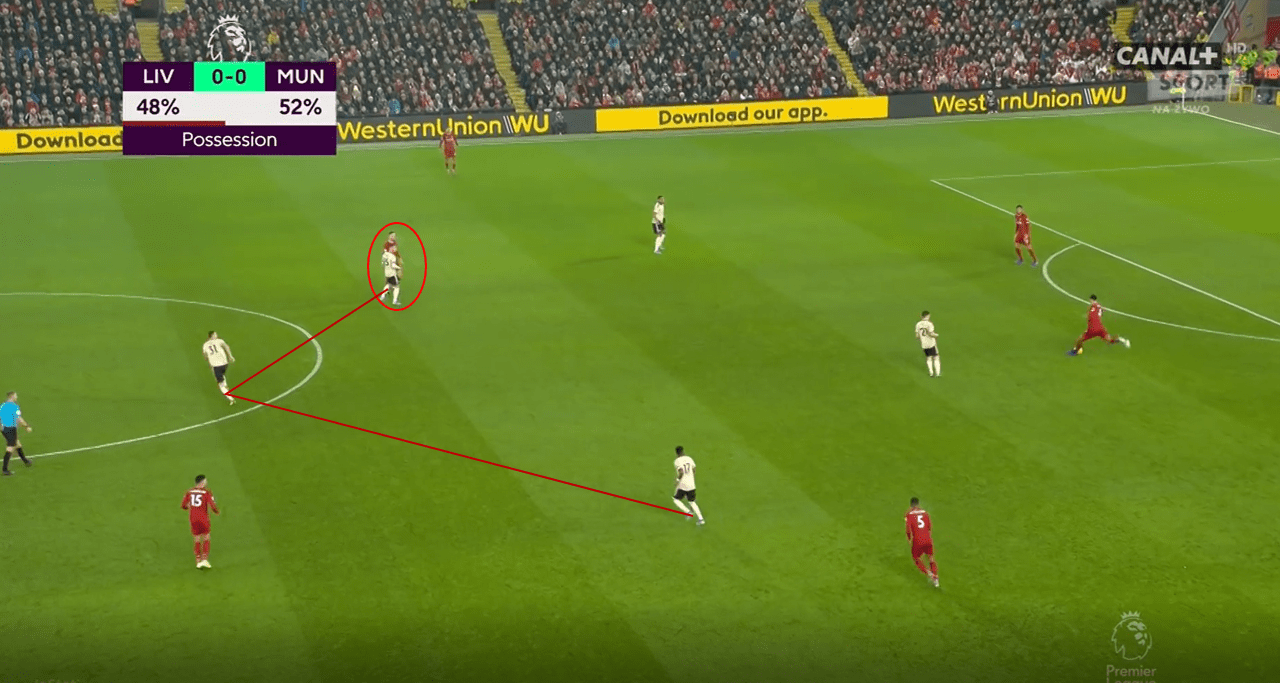
When Liverpool do go long, they ensure their staggering and counter-pressing around the second ball is good. Here, they have players at different heights in the space between United’s defence and midfield, and crucially, Firmino in a central position is closer to goal than the dropping Scott McTominay, and so Firmino can win the second ball and Liverpool attack.
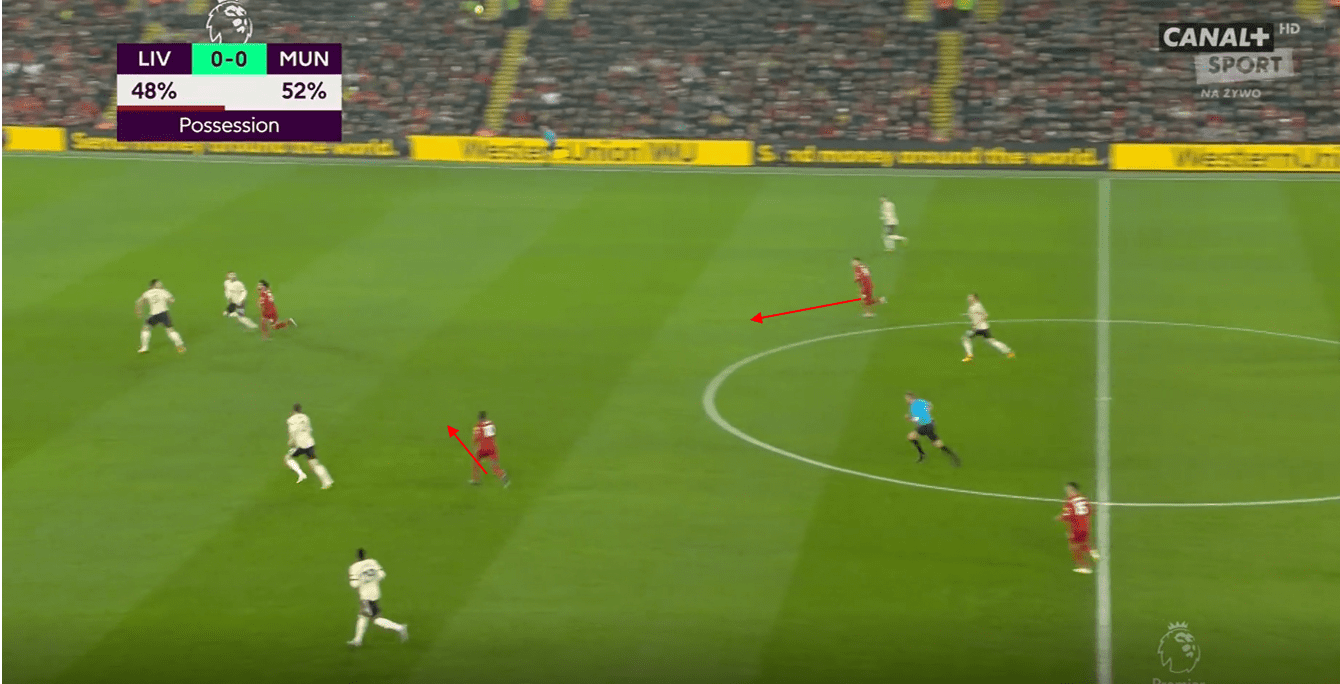
Harry Maguire will often drop deeper and earlier due to his lack of pace, and so when long balls when into his area, second balls, or even the first balls could be won. Here, Alexander-Arnold plays an excellent long ball into the arriving Oxlade Chamberlain, who drops in behind Mo Salah who drags Luke Shaw forwards. Chamberlain can just lay the ball off to Mo Salah who is arriving from a deeper position, and it is this staggering that allows them to either win the second ball, or run into space and keep up the pace of the attack.

As a result, going direct could be an effective route for Liverpool at times.
United’s 4-2-3-1
If I was choosing between either the 3-4-1-2 or United’s 4-2-3-1 system as it is, I would opt to use the 3-4-1-2 against Liverpool, although both systems have their advantages and disadvantages. We can see an illustration below of the 4-2-3-1 in use, with the lone striker pressing two centre backs. This is the first of the disadvantages for the press, as constant pressure is not always available, and even when it is, it can often be substituted for pressure or coverage elsewhere.
Midfield staggering remains the same, and so you still have two players deeper while one player can permanently occupy the Liverpool pivot, however with now only one striker to press two centre backs, access to these central midfielders is generally easier for the Liverpool centre backs. As a result, if Liverpool drop into a double pivot, it becomes much easier to actually utilise it, as strikers aren’t making pressing runs directly in front of these centre backs. United’s wingers and pressing ten also don’t remain too compact and narrow, and so protection of the half-spaces or far pivot can be poor at times.
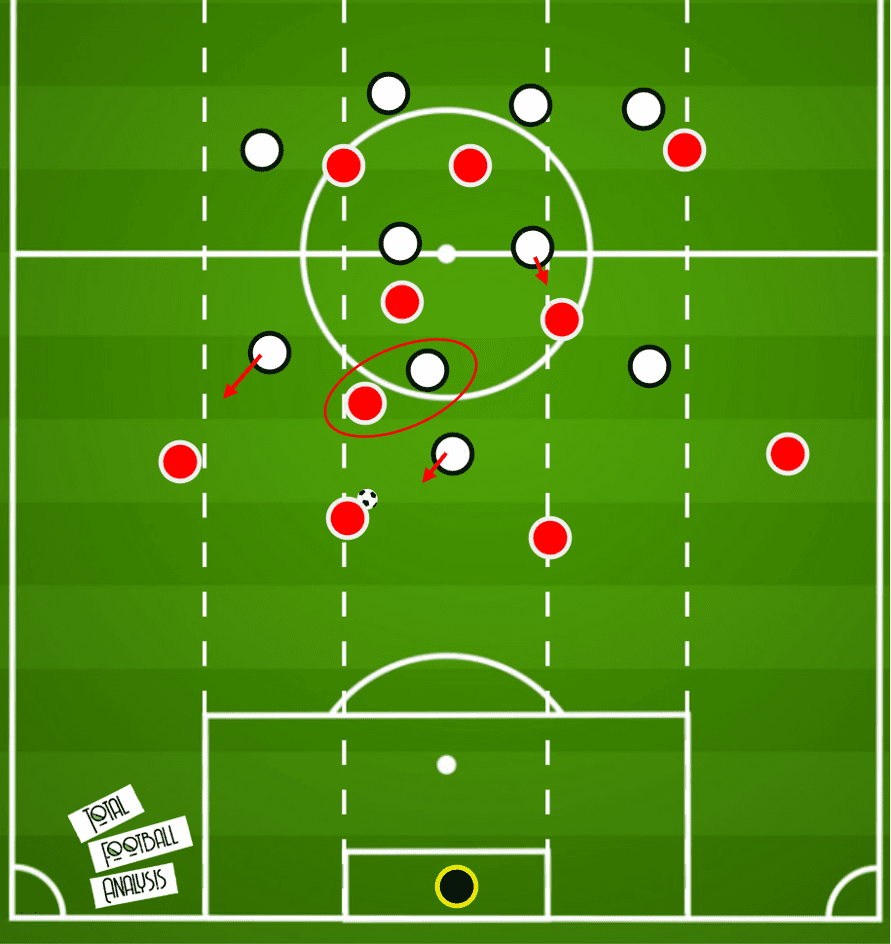
Bruno Fernandes has done a decent job of balancing between two pivots at times this season, but most teams with high quality in the build-up should be able to exploit this with constant switches of play and movement. We can see an example against Leicester where they switch the ball along the back line, with lacklustre pressure allowing the ball wide. Fernandes is still covering the far pivot from before the ball was switched and doesn’t make an effort to get across, and so McTominay now has to press the deeper pivot. Tielemans gets past McTominay via a dribble, but Leicester could just as easily find a pass beyond him also. Thiago is capable of both, and has his signature skill of using an opponents pressing momentum against them to shift the ball past them.
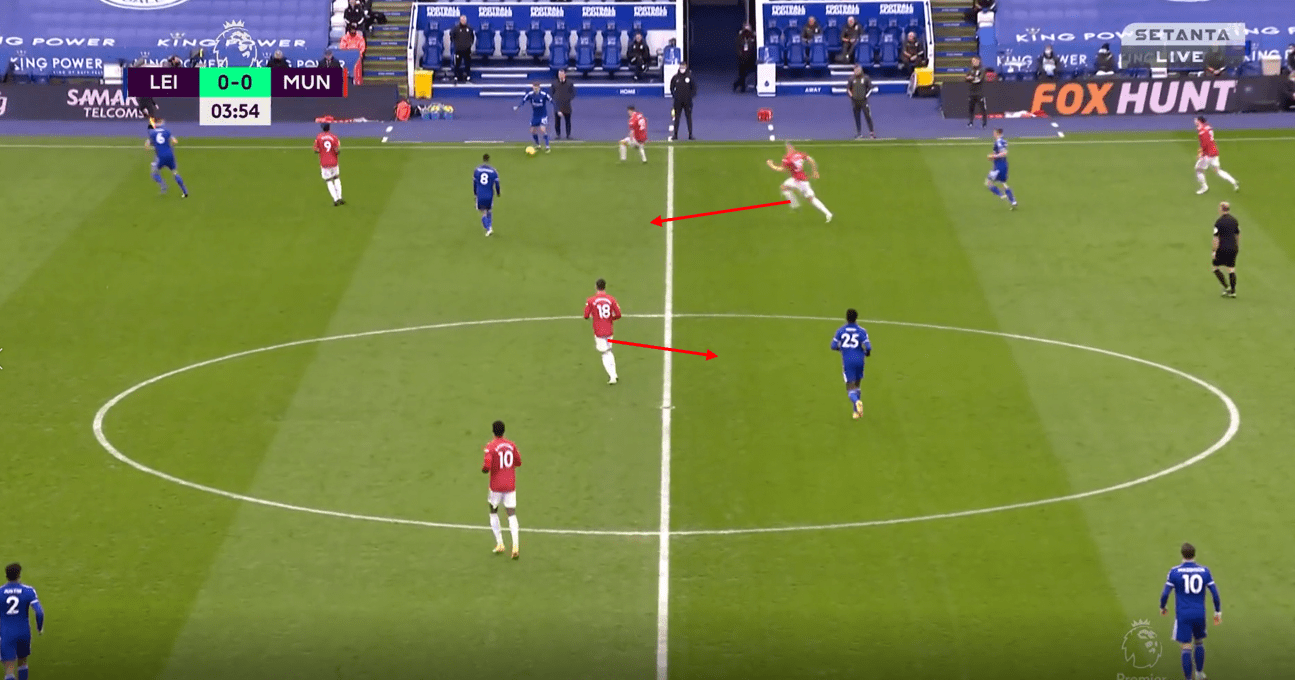
If United want to apply pressure on both centre backs, a common variation to the 4-2-3-1 is the 4-4-2, however this would then sacrifice the numerical equality in midfield, giving Liverpool an overload in midfield. United could look to cut access to this overload using cover shadows, but I’m yet to see any evidence of United using this effectively, and certainly players like Anthony Martial lack the discipline to perform this kind of role. United have situationally allowed Rashford to press inwards at times to keep pressure on the centre backs, but again I think Liverpool would be able to solve this quite quickly.
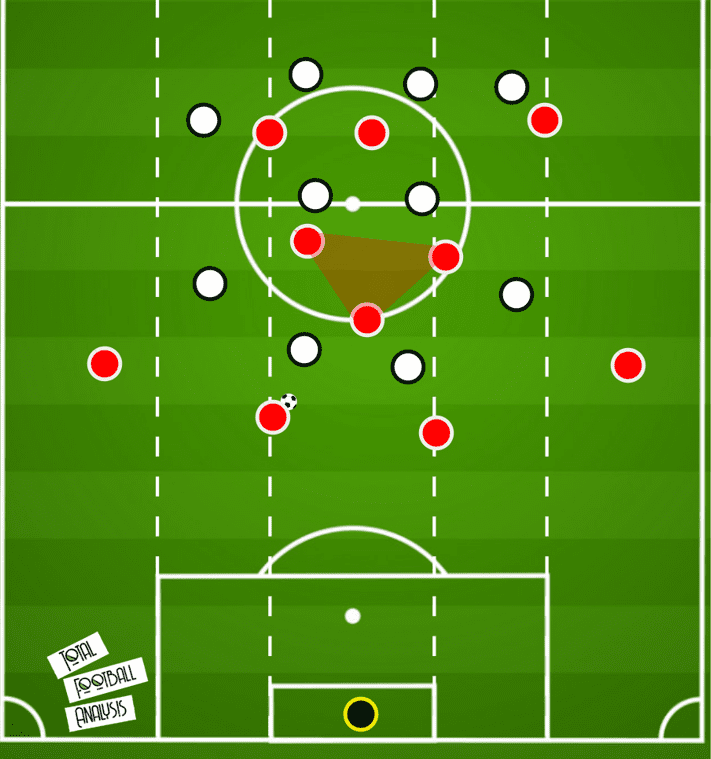
The 4-2-3-1 in high pressing can also be badly affected by the opposition dropping into a back three, which is something Liverpool do often. We can see below this illustrated, where if United want pressure on the ball, they end up in a shape similar to the 5-2-3 formation previously discussed. However, the full-backs are sat deeper, and so have to cover larger pressing distances, and United don’t have three central defenders (and a far wing-back) to shuffle across and cover the back line. Instead, they only have the two centre backs, and if one of them is Maguire, you can have one of Liverpool’s tricky inside forwards up against them. Furthermore, asmentioned with the 5-2-3, the half-space can be opened up more readily due to maximum width by Liverpool’s wing-back, and so when this is combined with United’s reduced coverage, Liverpool can overload the half-space more easily.
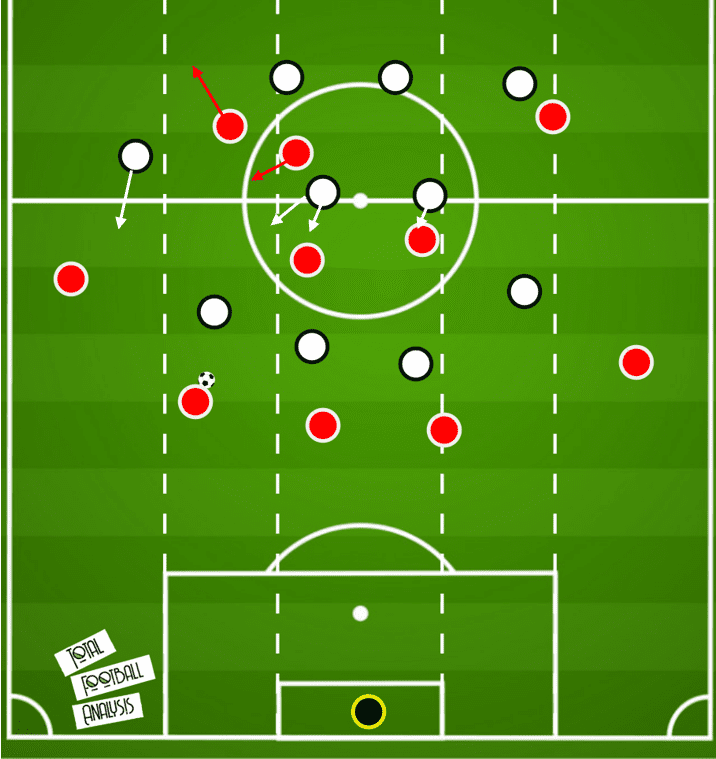
The main advantage or reasoning behind a 4-2-3-1 would be to provide extra cover in the last line, with Solksjaer maybe reluctant to go 3v3 at times with Liverpool’s front line. This however obviously comes with the cost of reduced pressure higher up. Again, this section is not to say that the 4-2-3-1 cannot be successful, as with good use of cover shadows and correct performance of roles United could still press effectively, but to be aggressive and also compact I believe the 3-4-1-2 would be the better option. The focus however is less on the formation/numbers, and more on the roles the players play within this system or shape.
Liverpool pressing and Man United’s attack
This section will briefly cover Liverpool’s expected pressing scheme against a back three formation, and will look at some key areas that Man United may look to exploit Liverpool.
Liverpool’s pressing shape won’t change, and they will stick to their 4-3-3 formation I would expect, with their usual eagerness to show the opposition into the central areas. We can see an example of their shape adjusted against Man United’s 3-4-1-2 here, with Firmino doing an excellent job of applying some pressure to the centre back while cutting the lane to the far pivot (McTominay). Liverpool’s two inside forwards prepare to press the wide centre backs from out to in, therefore cutting the wide pass off and showing United central, into a crammed Liverpool midfield three. With Firmino covering one pivot, Liverpool can remain stable with Wijnaldum barely having to push higher in order to occupy Fred. The long ball to the far full-back is left open, as longer passes give Liverpool time to get across the pitch to cover space, and Liverpool can also execute pressing traps from these kinds of passes.
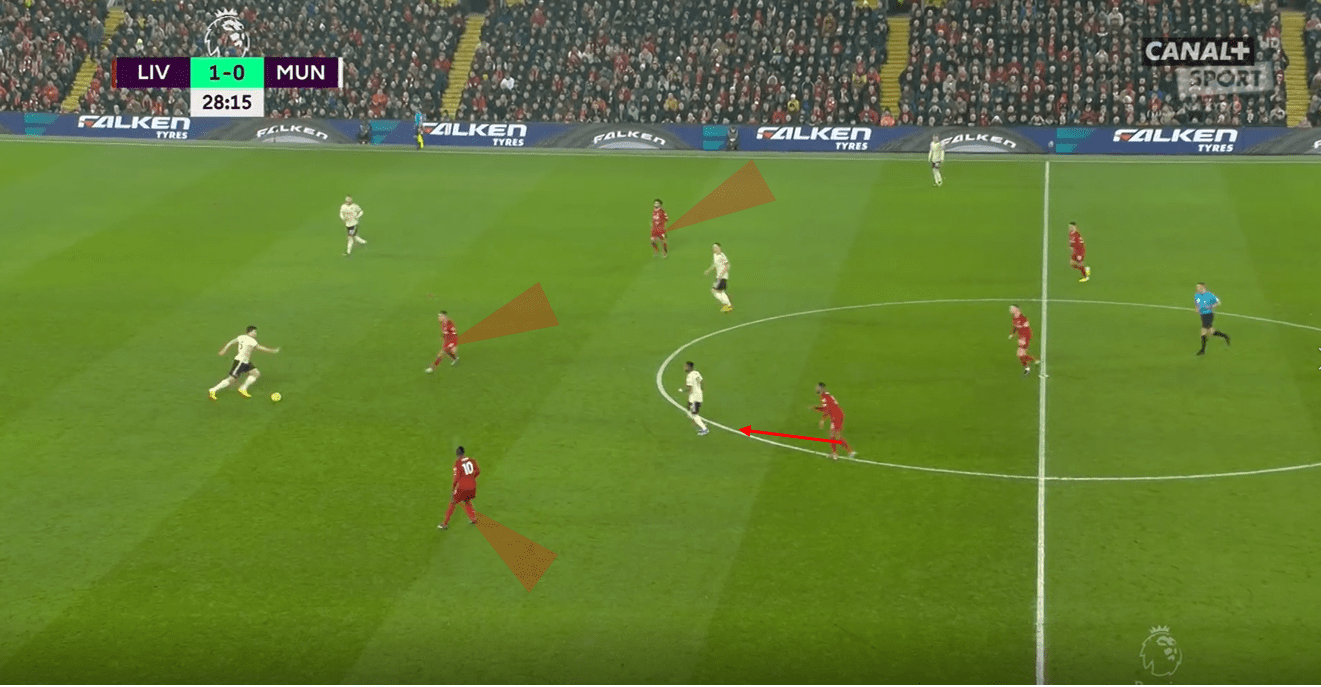
Liverpool executed the same pressing trap twice around Man United in wide areas from goal kicks, and so United should be wary of this, although it is very difficult to avoid. Liverpool press in their conventional way, with United in more of a central back two, with wide centre back Luke Shaw off screen acting as a deep full-back. Liverpool allow the pass into the centre, and Oxlade-Chamberlain applies fairly relaxed pressure on the pass into Matić. The ball is played into Luke Shaw off screen.
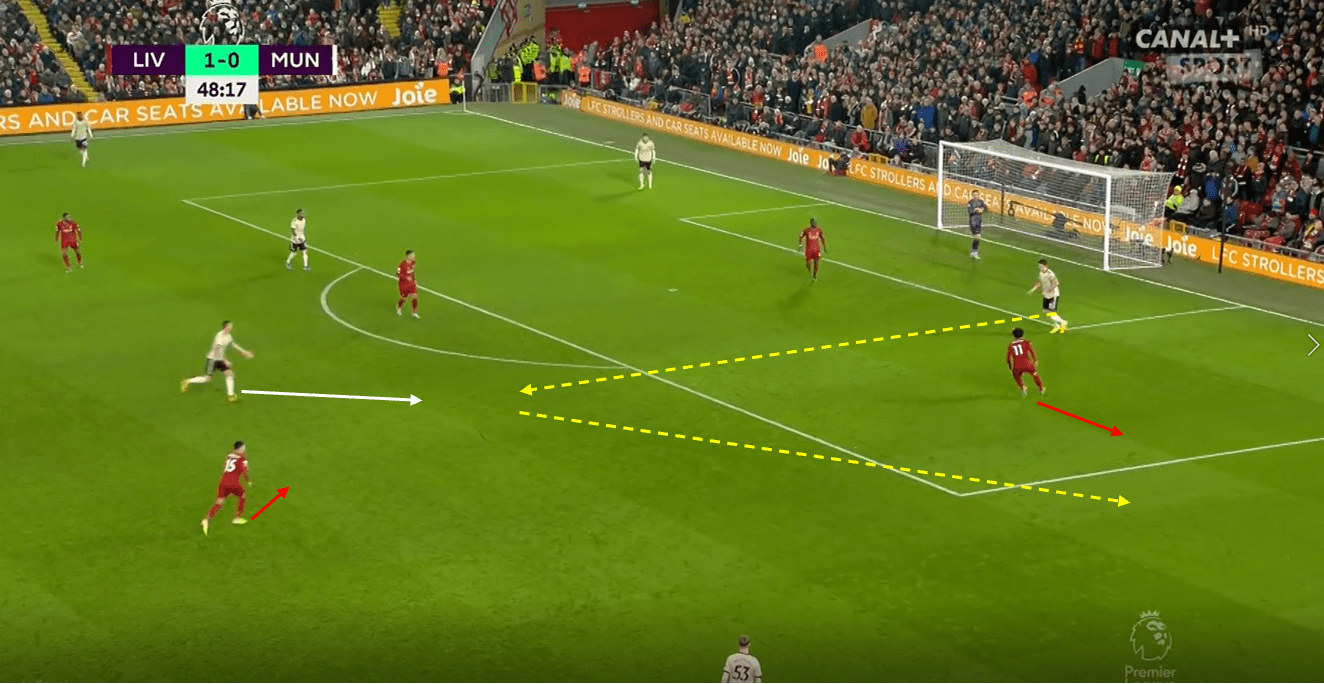
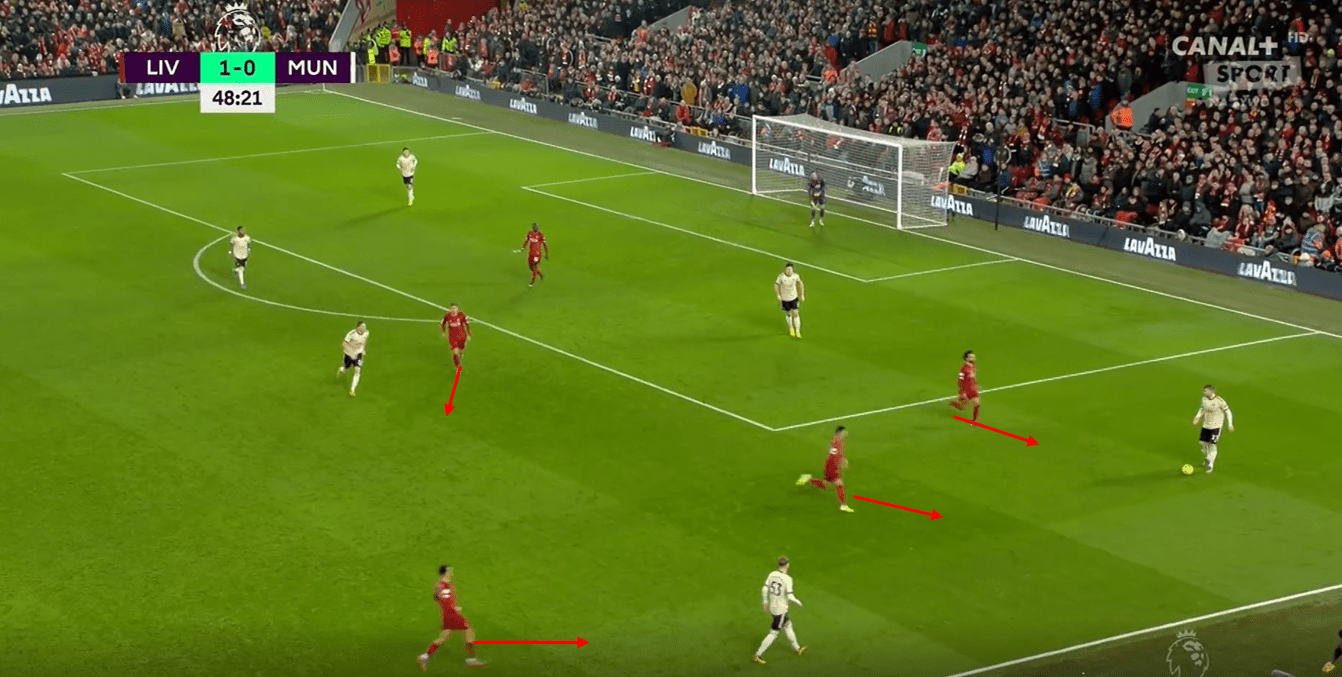
Once the pass is played into Matić originally, Salah turns around and begins to press towards Luke Shaw. Chamberlain carries his run on to press towards Shaw, while Alexander Arnold pushes higher onto wing-back Brandon Williams. As a result, Shaw’s nearby options are all cut off, and they are forced long to play a poor pass into the centre. Because Liverpool’s use of cover shadows and well-timed pressing runs, they still have two deeper midfielders ready to deal with this central pass, and so Henderson steps forward to nick the ball, and Liverpool then have a good rest offense to attack with, which leads to Henderson hitting the post.
For Man United to exploit Liverpool’s pressing system, they need to do lots of the things suggested to Liverpool such as rotating in midfield to create overloads, as well as testing Liverpool’s pressing orientations by dropping deep into double and single pivots (particularly around Firmino). A key area United may look to exploit is Liverpool’s high line. One observation I have noticed watching Liverpool this season is how their offside trap/high line significantly worsens when new centre backs are forced to play. Rhys Williams, Nat Phillips, and Jordan Henderson have all in recent weeks played players onside with poor body orientation, and so looking to make runs in behind whoever accompanies Fabinho (if it isn’t Matip), would likely be successful.
Much of Liverpool’s success from offsides relies on good body positioning and timing in the offside trap. Tiny details in Rhys Williams body orientation cause Liverpool to concede a goal here, as his trailing foot plays Son onside here. Liverpool and many other teams will have been specifically coached on reducing the area they take up vertically, and so by getting completely flat or standing side on, Williams would likely have played Son offside here. If we compare Fabinho’s body positioning to Williams we can see the difference.
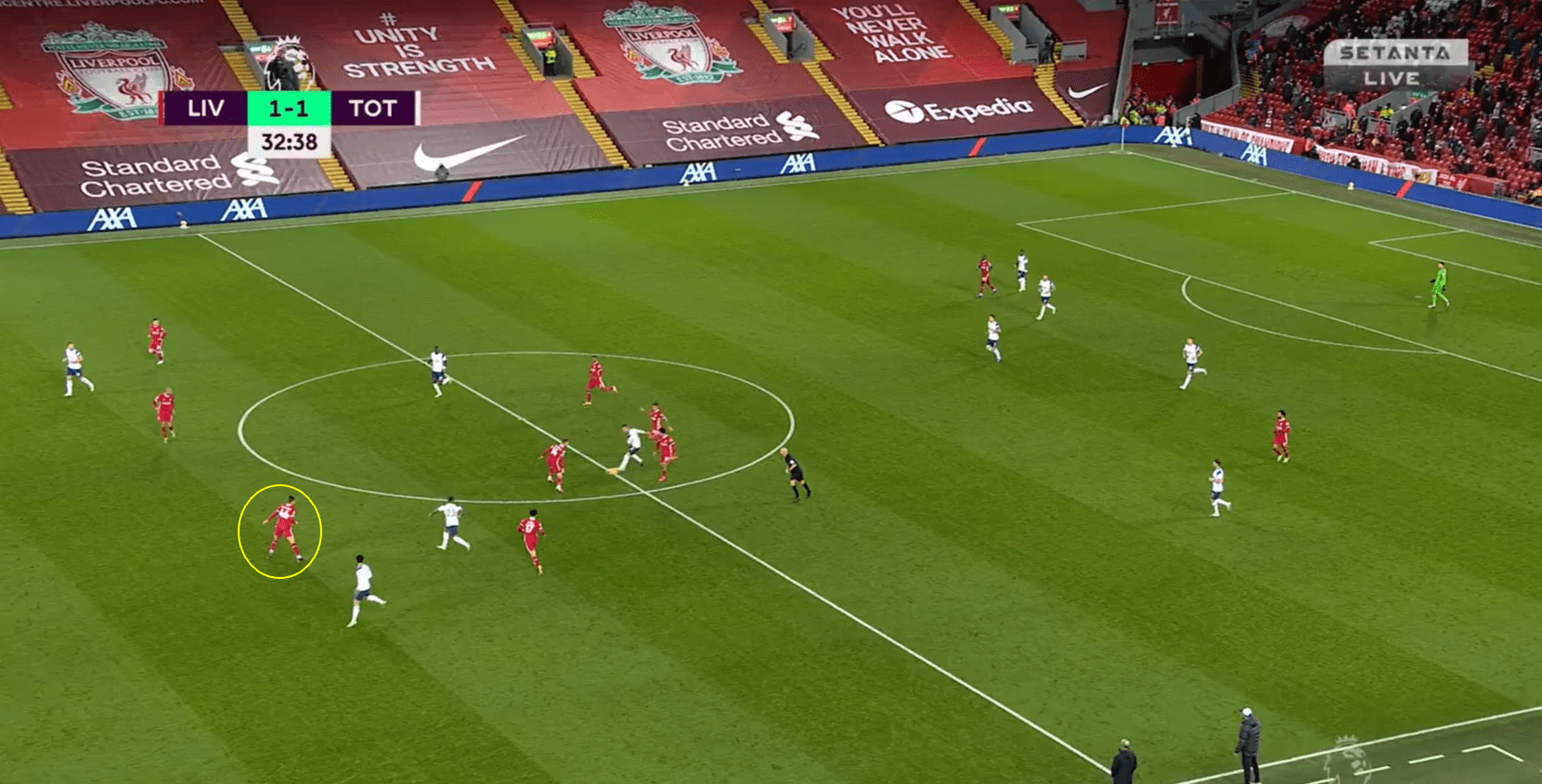
Liverpool’s centre backs lower down the pecking order don’t seem to have mastered this part of Liverpool’s game yet for whatever reason, and Nat Phillips struggled similarly against Newcastle. Phillips here commits the cardinal sin of defending in a high line, as he takes steps backwards to recover. This is an incredibly inefficient way of moving and turning to run in behind if needed, and so if Newcastle can play the ball here Phillips is in big trouble. Again we see Fabinho is stood side on, which helps to play offside and to sprint immediately back, whereas Phillips would have to step back, turn and then sprint, with those few extra steps likely to cost valuable time. Jordan Henderson is also unlikely to have practiced this much as he is a midfielder and so United may look to exploit this. Again this is’t to say Liverpool’s high line doesn’t work, in fact it is incredibly effective at stopping counters. However, like anything in football, it can be exploited if done well.
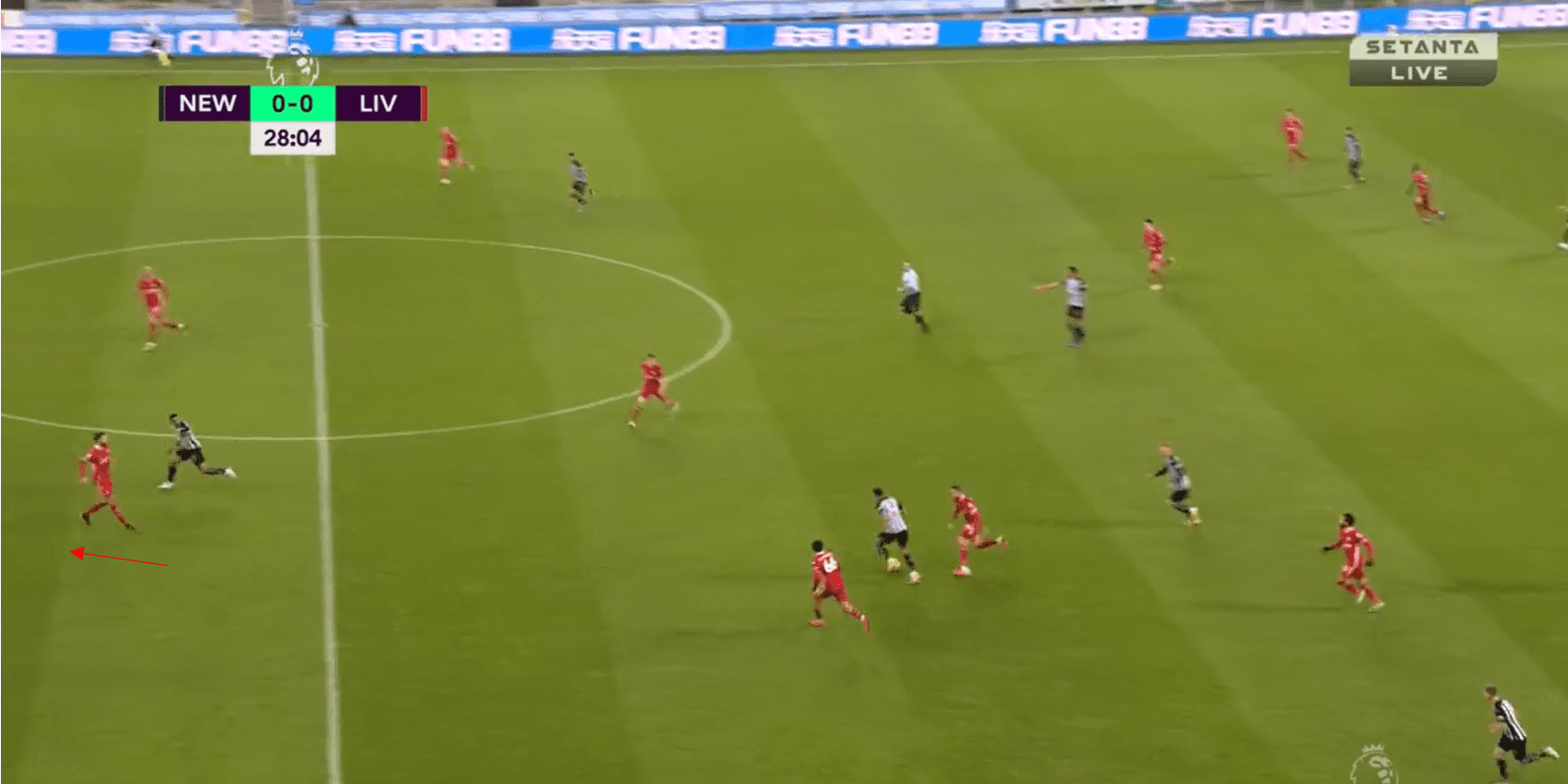
Conclusion
Overall this analysis has sought to give an insight into how both sides may approach the game, and the thinking behind both teams going into the game. Liverpool will likely go into the game favourites despite Man United being in a better run of form, and Liverpool will be looking to maintain their good run against the top six teams this season. Solksjaer faces many dilemmas both in terms of selection and shape, and it will be interesting to see how he matches up against Klopp’s side, and more importantly, how they are able to deal with Liverpool’s attempts to exploit them. A win for either team sends out a statement for the season, and so an interesting and exciting tactical battle awaits.





Comments